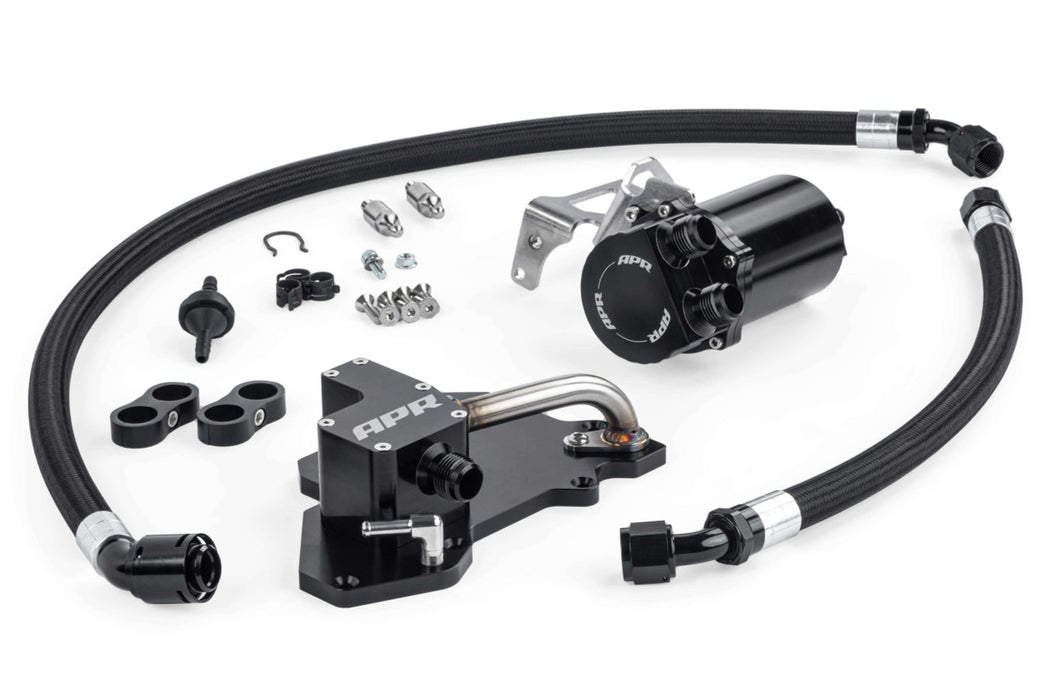
APR Full Catch Can System for VW/Audi MQB EA888 1.8/2.0T
by APR
Original price
$979.00
-
Original price
$979.00
Original price
$979.00
$979.00
-
$979.00
Current price
$979.00
APR Full Catch Can System for VW/Audi MQB EA888 1.8/2.0T
The APR Catch Can System with PCV Plate is a comprehensive upgrade to your engine's Positive Crank Ventilation (PCV) system. This factory-racecar-inspired-system takes a multi-step approach to addressing several performance-robbing issues, and critical engine safety concerns, with the factory system. The basis for the system is simple: Your engine's factory PCV system has several issues. The APR Catch Can System with PCV Plate addresses each one.
Features:
- Catches oil and gunk keeping your engine's air paths clean
- Increases performance by reducing octane-lowering oil vapors
- Prevents boost leaks from torn diaphragms and N80 valve issues
- Completely replaces the PCV system and addresses all failure points
- Helps prevent oil starvation and engine failure on the track and in high-G situations
- Internally baffled can with quick-draining valve
- High-quality hoses with a clean braided finish and swivel AN connectors
- Complete billet aluminum top-plate with proper T304 stainless steel oil separation and drain back
- Additional check-valve for the N80 valve
- Precision fit bracketry for a proper and clean fit
- Stand-off pegs for mounting the factory engine cover
- Attractive design looks right at home in your engine bay
- Fits most engine bays and modification configurations
The Problems
Firstly, when oil is sucked through the PCV system, it ends up in your intake tract. It’s sucked through your turbo, blown through the intercooler, and forced into the engine. Oil coats the intercooler, hoses, and everything in its path. Not only does this cause a mess, it lowers the effectiveness of the intercooler. More importantly, oil vapors lower your effective octane level, leading to performance-robbing, and engine damaging, knock. This means less horsepower and the possibility of engine damage.
Boost pressure and extreme heat are directly applied to the diaphragms within the PCV valve and the factory activated charcoal filter solenoid or N80 valve. Over time, the diaphragms can fail, leading to massive boost leaks and over-pressurization in the engine crankcase. Additionally, the N80 valve may not hold back the pressure, causing a boost leak into the activated charcoal filter. Boost leaks can result in a loss of power and may also lead to over-spinning of the turbocharger. Pressurization of the crankcase can force oil past the piston rings, creating engine-damaging localized pre-ignition points on the crown of the piston. Crankcase pressurization also leads to blown seals, including the rear main seal. Any of these scenarios can decrease horsepower, potentially cause turbocharger failure, and harm engine components.
Lastly, under racing, or hard-driving, and high G-force conditions, excessive amounts of oil can be forced through the system to be consumed by the engine. This goes beyond to light oil, and vapor ingestion discussed above. This is excessive mounts that cause plumes of smoke to pour from the exhaust, and engines to fail due to oil starvation. Oil starvation is a serious condition that can cause engine failures in fractions of a second. Often times when any warning of starvation has occurred, it’s already too late.
The Solution
Firstly, the factory PCV is eliminated. New race-inspired oil separation and drain-back system, or top-plate, is installed. The top plate is diaphragm-free, effectively eliminating the boost activated fail-points on the factory design. The active charcoal filter port remains, but a newly installed check-valve acts as another line of defense before the N80 valve. Internally to the plate baffles keep oil from spilling out of the system. All oil galleys, including the coarse oil separation galley, remain, promoting proper evacuation of crank-case gasses, and proper drain-back of oil into the engine, rather than the catch can.
Next, the APR catch can sits between the plate and the turbo inlet. Crankcase gasses built up within the engine and must be evacuated. The plate prevents coarse oil from easily spilling into the can. Remaining vapors and moisture travel through the can’s multiple layers of internal baffling, collecting in the can while leaving cleaner gasses to escape the system. This leaves your engine happy and clean, promoting more power, engine safety, and engine longevity in even the most demanding of situations!
The top plate, lines, and can all mount cleanly in the engine bay and are made from black-anodized billet aluminum, with a T304 stainless coarse oil separation galley tube. The can drains easily with the integrated drain valve. All plate mounts are top-side, eliminating the chance of parts coming loose and falling into the cylinder head. High quality braided lines with swivel AN fittings and hose guides are included for a clean and professional-looking install. Billet stand-off pegs allow you to raise and retain the engine cover, should you so choose. Precision bracketry makes for an easy, and solid install. Lastly, an optional washer fluid reservoir also allows for usage of the system on vehicles that otherwise would have a washer fluid reservoir blocking the install.
Applications:
- Audi A3 (8V) 1.8T (2014-2016)
- Audi A3 (8V) 2.0T (2014-2020)
- Audi S3 (8V) 2.0T (2015-2020) - REQUIRES Washer Relocation Kit
- Audi TT (8S) 2.0T (2016-2020)
- Audi TTS (8S) 2.0T (2016-2020) - REQUIRES Washer Relocation Kit
- Volkswagen Alltrack 1.8T (2016-2018)
- Volkswagen Arteon 2.0T (2019-2020) - REQUIRES Washer Relocation Kit
- Volkswagen Atlas 2.0T (2018-2021)
- Volkswagen Beetle 2.0T (Gen3)
- Volkswagen Golf R (MK7) 2.0T (2015-2020) - REQUIRES Washer Relocation Kit
- Volkswagen GTI (MK7) 2.0T (2015-2021)
- Volkswagen Jetta (MK7) 2.0T (2018-2020)
- Volkswagen Passat 2.0T (2018-2020)
- Volkswagen Tiguan 2.0T (2018-2020)




